Honeymoon Bay Community Hall History
The community hall was officially opened on February 7th, 1948. The weather was foul but that didn't stop approximatly 450 people from being present at the grand opening of the hall.
The management and staff of W.F.I were on hand for the gala opening. An evening of music, with a live band from Victoria was enjoyed by all. as were the refreshments supplied by the Honeymoon Bay Employees and Athletic Association. Mr. Brian Gattie manager of all W.F.I. operations was on hand to give a short address and welcome guests. Employees and friends came from all over Vancouver Island for the event, despite bad road conditions.
Residents could certainly be proud of their hall and grounds. Ideally situated in the town site, surrounded by park and tall firs. Tennis courts flanking one side, with a recreational field at the back. At the time of the opening the kitchen was not yet installed and the dining room was a later addition.
The hall itself was large, well lit with a generous stage and dressing rooms. Edge grain fir was used for the floors throughout the building as was fir panelling for the walls. The hall was to be used for dances, motion pictures, dramatic entertainment and indoor sports and for community meetings. (Katza Vignettes-- The Lake Cowichan News-- Kaatza Museum)
From Memories: Honeymoon Bay 50 Years by Marian Bates.
Honeymoon Bay Community Hall Murals

Honeymoon Bay is home to a little known art treasure. It holds as its window on the past, six large murals by well-known Victoria artist George Jenkins.
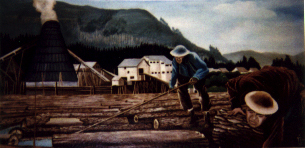
Born in 1920, George spent his youth on his family's farm in Lloydminster, where he sketched the birds and animals he observed around him. he moved to BC in 1946 and began working in logging camps and mills, but as the lumber industry proved to be sporadic with its shutdowns and strikes, he began to concentrate more effort upon his paintings.
His first mural, painted for the Malahat Lookout, was the view from the coffee shop window as consolation for tourists who had the misfoutune of stopping on a foggy day. He painted a mural above the bar in the Buena Vista in Cowichan Bay. This was the first mural he painted on site. For his efforts, he was paid $15. This mural led to two others in the same establishment, plus one in the Elks Hall in Duncan, one in the Skylark Cafe, one in the Atlas Cafe and another in Westholme Hotel, all in Victoria. The Elks Mural, painted in 1954 for $50 is the only one remaining in this group.
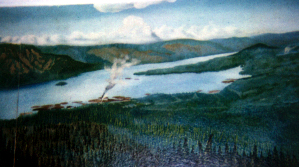
In 1952, he was commissioned by Western Forest Products to paint 6 murals on the 3 exposed support beams in the Honeymoon Bay Hall hall's new dining room. Each beam spans 28 feet. Armed with sketches and photographs of life around town, he began his task.
The first mural shows the vastness of the range surrounding Honeymoon Bay and Cowichan Lake with details of the logging operations, the mill and log booms in the lake. The second mural is an extended view of waterfowl in a marsh with a beaver swimming not far from his lodge. The third mural is a detailed portrait of the Honeymoon Bay Mill. The fourth mural is of Skutz Falls with a bear fishing for salmon. The fifth mural is a montage of the many recreational activities and a cougar hunting a deer, etc. The sixth mural "Roosevelt Elk" is a night winter scene of a herd of elk hunted by a pack of wolves.
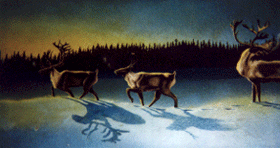
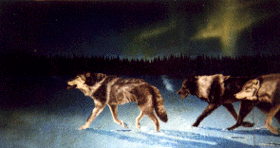
The murals have survived roof collapse, years of smoky parties and neglect. They are in very good condition but are in need of professional cleaning and preservation.
They truly are a treasure and a source of pride.
They have been valued at more than $60,000.
From Memories: Honeymoon Bay 50 Years by Marian Bates and the files of Merna Moffat.
A Brief History of Honeymoon Bay

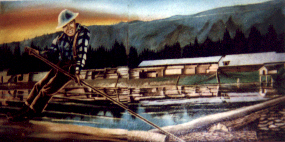
In its infancy, Honeymoon Bay was a true working town, that is, if you lived in Honeymoon Bay, chances are you were employed by Western Forest Industries Mill which was located on the shores of what is now the Central Beach area and March Road.
The homes on the original townsite were built and completed by WFI in 1947 and construction of the duplexes began in March of the same year. These homes were rented to mill workers and their families. 1947 also saw the formation of the Fire Department and the opening of the first post office.
WFI was a rather benevolent employer, taking care to ensure Honeymoon Bay was a thriving community with many recreational activities. The Community Hall was officially opened in February of 1948, as well as a park for the children and tennis courts for the residents to enjoy.
Catastrophe struck the first time in July 1948 when the mill was destroyed by fire leaving 500 unemployed. Fortunately, the shut down was not permanent and the mill was rebuild and began operation again in 1950.
The community was very active during the '50s, taking part in such activities as badminton, square dancing, card parties and garden clubs.
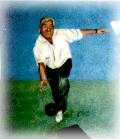
A unique thread in the fabric of Honeymoon Bay history is the Honeymoon Bay Lawn Bowling club which was formed in 1952. Originally, the club was for employees of WFI but later became open to all residents of Honeymoon Bay. The club was very active during the 1950s and '60s and was dissolved around 1976. The original club hut still stands in the playground in the centre of the townsite.
March Meadows Golf and Country Club officially opened in October of 1970. The challenging nine hole course was developed using the natural lay of the land and is the original home of LPGA star Dawn Coe-Jones.
The mill closed its doors in 1981, causing profound unemployment and creating an era of confusion for those who occupied the homes in the original townsite. Many of these residents were able to eventually purchase the dwellings for a reasonable price but most had to leave the area in search of employment.
Despite setbacks Honeymoon Bay continues to flourish. Although some residents have left, development and the low cost of housing make it attractive for others to purchase in the area, many of which are young families drawn by the charm of a small community.
The townsite still boasts the community hall, the volunteer fire department, a general store, butcher shop and post office. As well there's been an impressive modernization of the elementary school.
Today, the RV parks-three in total-have boosted the summer population of Honeymoon Bay immensely.

Tourists are attracted to the beauty of the area and recreational activities include camping at Gordon Bay Provincial Park, walking through the Wildflower Reserve, golfing at March Meadows or visiting any number of beaches.
In 1997, Honeymoon Bay saw the gas station at the entrance to town re-open as well as a neighbourhood pub-the Cutthroat Tavern-open for business.
One cannot have a complete history of the Bay without mentioning the first resident, Henry March. Very much a pioneer braving untouched wilderness, March came to the Bay in 1887 and cleared a site with the aid of horses and oxen that became the March farm, of which the original house still stands today.
From a booming mill town to the spectre of becoming a ghost town, few could have seen how Honeymoon Bay would become the tourist destination it is today. For those who live there, however, Honeymoon Bay will always be seen, first and foremost, as home.
This history first appeared in the Lake Cowichan Gazette, July 30 1997-by Kelly Johnston.
Henry March

In 1887, Henry March, age nineteen, arrived at Greendale, the home of Frank green after leaving a secure home and future in england for greener pastures in Canada. With only a few dollars he began to look for land with the help of Frank Green. This was the start of a sixty year friendship between the two men. Henry obtained 64 hectaires of prime land near Honeymoon Bay, later increased his holdings to 240 hectares, then sold off 80 hectares. He courted Edith Wardroper, who lived on the North Shore of the lake with her brother, Capt. Wardroper, and they married in Victoria in 1893.
After having the land logged, Henry stocked the farm with poulty, pigs, a cow and a yoke of oxen. As there was no road from his property, he would paddle his canoe every few days to the store at the foot of the Lake, now the village of Lake Cowichan, to trade butter, eggs and vegetables for essential supplies. Their sons, Jack and Charles, were born in 1896 and 1898 respectivly. In 1900 Henry cleared a 10 km long trail to the foot of the lake and later constructed a telephone line in conjunction with Mr Ashburnham who lived at what is now known as Ashburnham Beach.
Henry became the first local justice of the peace. The sons were sent to school in Duncan to attain their primary school education and returned to the farm during summer and winter holidays. During World War I, Jack served four years overseas, returned home unharmed, and then unfortunatly lost his life in a logging accident. Allison Pollock came from England to visit the Marches. She and Charles soo wed in Duncan in 1932. They had one daughter, Susan.
Henry died in 1950 at age 83. Alison, Charles' wife, died in 1970 and Charles died in 1977. The old March farm still stands and march meadows Golf course sits on the site of the old hay meadow.
(Compiled from information provided by Sue Boulton)
From Family Trees: The Growth of a Forest Community.
 Honeymoon Bay, British Columbia
Honeymoon Bay, British Columbia

